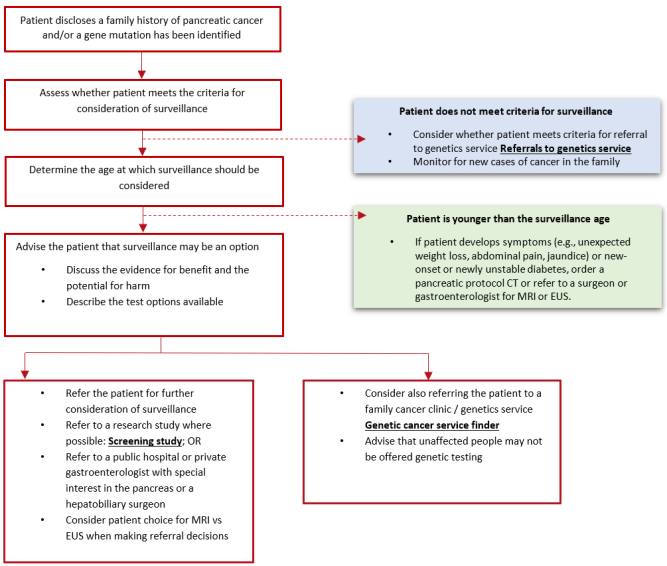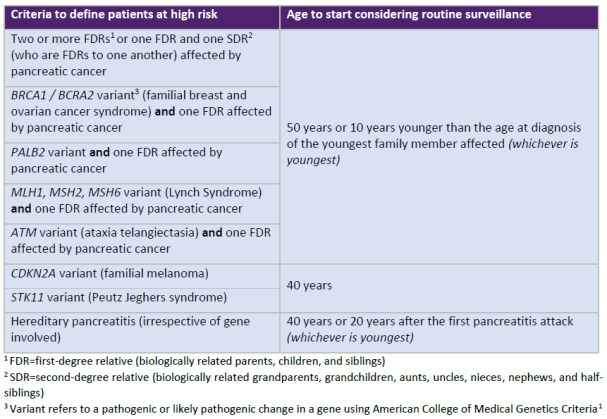Integrated approach to pancreatic cancer
Diagnosis and surveillance
Content developed in collaboration by researchers by University of Queensland Australia
Overview
Pancreatic cancer remains one of the most challenging cancers to detect early. These clinical resources are designed to support primary care practitioners in identifying individuals at increased risk, guiding appropriate surveillance, and expediting diagnosis. It provides practical, evidence-based recommendations on risk classification, imaging options, and referral pathways empowering clinicians to make informed decisions and support patients effectively throughout their care journey.
Diagnosis
Purpose of this Clinical Guidance Section
Full document available here
This section aims to support primary care practitioners in the early recognition and timely management of suspected pancreatic cancer. It focuses on:
- Enhancing primary care practitioners’ recognition of the signs and symptoms that may indicate pancreatic cancer.
- Providing guidance on appropriate initial investigations when pancreatic cancer is suspected.
- Improving the timeliness and appropriateness of referrals to specialist services for further assessment and management.
By strengthening these areas of practice, this resource seeks to minimise delays in diagnosis and contribute to better outcomes for patients with pancreatic cancer.
Clinical Recommendations
1. Urgency of Investigations (click here for full information):
Symptoms are categorized into two tiers:
- Tier 1: Urgent investigation for pancreatic cancer is recommended.
- Tier 2: Consider ruling out more common conditions or trial management before investigating for pancreatic cancer
Click on the dot points below for further information
Tier 1 |
Consider urgent1 contrast CT (pancreatic protocol) or referral to a gastroenterologist with special interest in the pancreas or a hepato-pancreatico-biliary surgeon.
Tier 2 |
Consider CT if another cause is not found within 6 weeks or blood glucose does not respond to medical management within 3 months.
2. Age Considerations:
Pancreatic cancer is rare in patients under 60. However, it should still be considered in younger patients with relevant symptoms, especially if there is a family history or history of pancreatitis. Imaging is not recommended for new-onset diabetes in patients under 60 unless other risk factors are present. Click here for full information.
3. Investigations:
- Preferred Imaging: Pancreatic protocol CT scan.
- Additional Imaging: Abdominal/pelvic CT may be appropriate for non-specific symptoms or to rule out other cancers.
- CA19-9 Marker: Not recommended for initial triage due to limited specificity but may assist in secondary care if a lesion is found. Click here for full information.
4. Referrals:
Patients with pancreatic lesions should be referred to a gastroenterologist with pancreatic expertise or a hepatopancreaticobiliary surgeon. Referral to high-volume centres with multidisciplinary teams is preferred, considering patient access and preferences. Click here for full information.
Link to full document: Identifying and investigating patients who may have undiagnosed pancreatic cancer here
Surveillance
Purpose of this Clinical Guidance Section
Full document available here
This resource provides primary care practitioners with key principles and practical guidance on pancreatic cancer surveillance for two patient groups:
- High-Risk Individuals (HRIs): Patients with a family history or a known pathogenic germline variant (gene mutation) associated with an increased risk of pancreatic adenocarcinoma.
- Patients with Incidentally Discovered Pancreatic Cystic Lesions: Individuals in whom a pancreatic cyst has been found during imaging for unrelated reasons.
The goal is to assist primary care practitioners in identifying patients who may be classified as HRIs and to offer clear recommendations on when and how to refer these patients for specialist assessment and potential surveillance.
Core Principles of Surveillance for High-Risk Individuals (HRIs)
1. Informed Decision-Making
HRIs should be supported to make informed choices about surveillance, including understanding potential benefits and harms. Referral to a genetic counsellor or pancreatic specialist is recommended for detailed discussion. Click here for full information.
2. Specialist Expertise
Surveillance should be conducted by clinicians experienced in pancreatic disease, ideally within a multidisciplinary team, to ensure accurate diagnosis and appropriate management. Click here for full information.
3. Imaging Choices
HRIs should be involved in selecting the imaging modality, with clear information provided on sensitivity, risks, costs, and accessibility of each option. Click here for full information.4
4. Data Collection
Given limited evidence on surveillance outcomes, HRIs should be encouraged to participate in research studies. Click here for full information. The APRISE study is open in Australia.
Decision flow chart: patients at high risk of pancreatic cancer
1. Link to eviQ guidelines: Guidelines for referral to genetics services
2. For enquiries about the research study, please contact EC-APRISE@epworth.org.au
3. Link to genetic service finder: Genetics services
4. Variant refers to a pathogenic or likely pathogenic change in a gene using American College of Medical Genetics Criteria - click here to find out more
5. Link to Referrals to genetics service
6. Link to Screening study
7. Link to Genetic cancer service finder
Clinical Recommendations
1. Definition of High Risk and Age for Surveillance
Patients are considered high risk based on family history or the presence of a known pathogenic germline variant.
Table 1: Criteria for defining risk and age to begin surveillance

2. Aboriginal and Torres Strait Islander People at High Risk
Care for Aboriginal and Torres Strait Islander people should follow culturally safe practices. Clinicians must recognise that family structures may extend beyond biological relationships and approach discussions with sensitivity. Click here for full information.
3. Advising High-Risk Individuals About Surveillance
Surveillance may detect pancreatic cancer earlier, but its overall benefit is uncertain. The cancer detection rate is low (~5 per 1,000 annually), and some cases are still diagnosed at advanced stages.
Potential harms include unnecessary procedures, complications from tissue sampling (~2%), and surgery for low-risk lesions, which may lead to diabetes or other issues.
Patients should be referred to a pancreatic specialist to discuss risks, benefits, and whether surveillance is appropriate. Click here for full information.
4. Identifying high-risk individuals
The RACGP Red Book recommends updating family cancer history every 3 years. GPs should ask about cancer in first- and second-degree relatives. For patients with known gene mutations linked to pancreatic cancer, ask annually about new diagnoses in close relatives. Click here for full information.
5. Imaging options for surveillance
Three imaging modalities are used for HRIs: MRI, EUS, and CT. Each has benefits, limitations, and varying accessibility.
- MRI is preferred for initial surveillance due to its balance of sensitivity and safety. Quality depends on equipment and radiologist expertise.
- EUS offers superior detection of small lesions and allows tissue sampling but requires sedation and is less accessible. Not suitable for hereditary pancreatitis.
- CT involves radiation exposure and is generally avoided in asymptomatic patients. It is only recommended if MRI or EUS are not feasible.
Primary care practitioners should discuss imaging options with patients to guide appropriate referrals based on clinical needs and patient preferences. Click here for full information.
6. Referring high-risk individuals for consideration of surveillance
Patients considering surveillance should be referred to one of the following:
- A pancreatic cancer screening study such as APRISE.
- A high-volume hospital or clinic with access to expert imaging and a multidisciplinary team.
- A specialist (gastroenterologist or HPB surgeon) outside a high-volume setting, with access to expert imaging review.
Referral decisions should consider patient preferences, including cost (public vs private), travel, and imaging modality. Click here for full information.
7. Referring patients for genetic counselling
Primary care practitioners should consider referring patients who meet eviQ criteria to a clinical genetics service or family cancer clinic. Criteria include:
- A blood relative with a pathogenic variant (e.g., BRCA1/2, PALB2, Lynch syndrome genes).
- A strong family history of related cancers (e.g., breast, ovarian, pancreatic, colorectal).
Genetic testing is not Medicare-funded for unaffected individuals and may yield uncertain results. Testing is more informative if an affected relative is available. Genetic counselling is recommended and can be offered alongside or prior to referral for surveillance. Click here for full information.
8. Investigations of the pancreas in high-risk individuals diagnosed with diabetes
New or unstable diabetes in a high-risk individual (HRI) may signal pancreatic cancer. Imaging with a pancreatic protocol CT should be performed regardless of age. If the patient is already under surveillance, additional imaging should be arranged or the patient should be advised to consult their specialist. Click here for full information.
9. The age at which surveillance should not be considered or should cease
Surveillance should not begin—or should be paused—if a patient’s age or comorbidities make pancreatic surgery unsuitable. This decision should be made in consultation with the patient and, if needed, a specialist. Click here for full information.
10. Referring patients with cystic lesions identified incidentally
Most cystic lesions found incidentally do not progress to cancer, but further investigation is recommended unless a radiologist advises otherwise or the patient is not a surgical candidate. MRI is preferred for characterizing cysts; CT is an alternative if MRI is unavailable. Patients should be referred to a high-volume HPB clinic or a pancreatic specialist. Click here for full information.
More detailed learning on diagnosis and surveillance can be found in the upcoming online module, check back here soon.